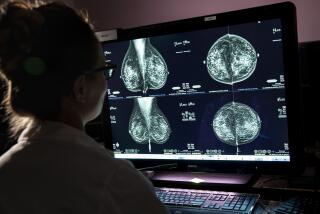More Cancer Risk Seen in Full-Body CT Scans
- Share via
Whole-body CT scans, long controversial because of doubts about their effectiveness in finding hidden disease, can significantly increase the recipient’s risk of developing cancer, according to a study released Monday.
The radiation from a single whole-body scan is equal to that from 100 mammograms and is similar to that received by survivors of the atomic bombings of Hiroshima and Nagasaki, Japan -- about 1 1/2 miles from the explosions -- according to radiation biologist David J. Brenner of Columbia University.
The radiation from one scan is enough to produce a tumor in every 1,200 people who undergo the procedure, reported Brenner and coauthor Carl D. Elliston of Columbia in the journal Radiology. For those who have annual scans, the risk goes as high as one tumor in every 50 people, they said.
“The risks for a single scan are not huge,” Brenner said. “But if you have them repeatedly, the risk starts to build up quite a lot and becomes quite significant.”
Brenner cautioned that his results applied only to healthy individuals who chose to receive the scans. “The risk-benefit equation changes dramatically for adults who are referred for CT exams for medical diagnosis,” he said. “Diagnostic benefits far outweigh the risks.”
CT scans, short for computerized tomography, are produced using an X-ray source that travels from head to toe, spiraling around the body. Powerful computer programs integrate the data to produce three-dimensional images of the body in high detail.
The tests, which cost $800 to $1,500, are heavily advertised, with slogans touting the device’s ability to detect hidden diseases. The most commonly sought diseases are cancers, especially lung cancer.
Whole-body CT scans have surged in popularity since they were first used in the mid-1990s, converting a procedure once reserved for the seriously ill to a commonplace screening technique that reached a peak of 32 million scans in 2002.
Southern California has been the nexus of the growth, with as many as 30% of the nation’s screening centers located in this area. Several have closed in the last year, however, because the market became saturated.
The total number of scans also has been declining because of the slow economy, according to Bruce Friedman of Heart Check America, one of the largest centers in Los Angeles.
Friedman said he thought that the study meant that “it is worth talking about the risks as well as the benefits.” He doesn’t think the study is a reason for people to get scared, but he recommends caution.
Even though 15% of his business is for whole-body scans, Friedman said, “I have never had a full-body scan, and I wouldn’t recommend one to anyone I know who doesn’t have a reason to think they are sick.”
Many health-related agencies and organizations, including the Food and Drug Administration, the American Cancer Society, the Environmental Protection Agency and the American College of Radiology, recommend against elective whole-body scans.
An FDA statement says that the agency “knows of no data demonstrating that whole-body CT screening is effective in detecting any particular disease early enough for the disease to be managed, treated, or cured and advantageously spare a person at least some of the detriment associated with serious illness or premature death.”
Similarly, the Health Physics Society, a major organization of radiologists, says that “no medical use of radiation should be employed unless there is a clear medical benefit,” which is not the case for whole-body CT scanning. “Generally, people with no symptoms have a very low prevalence of disease.”
For the same reason, most insurance companies do not pay for the scans.
Texas and Pennsylvania have banned the scans unless the patient is referred by a physician, and other states are thought to be considering similar actions. Major medical centers including Cedars-Sinai also require a physician’s referral.
No one has been documented to have a tumor caused by whole-body CT scans -- at least in part because the technique has been around for only a few years and radiation-induced tumors take decades to develop.
The analysis used data from atomic-bomb survivors, Brenner said, because they have been studied for more than 50 years, long enough for most potential cancers to occur.
Brenner and Elliston found that one CT scan exposes the recipient to about 12 millisieverts of radiation. Atomic-bomb survivors in the low-dose range received 5 to 100 millisieverts and showed a statistically significant increase in risk of solid tumors, such as cancers of the lung and digestive system.
They calculated the highest risk -- one tumor per 50 people -- for patients who received annual scans for 30 years beginning at age 45.
Previous controversies about whole-body scans have centered on their sensitivity, which reveals many abnormalities that prove to be harmless, but which must be studied further, often with invasive techniques.
A 2002 study by Dr. Giovanna Casola and her colleagues at UC San Diego found that about a third of patients receiving the whole-body scans required follow-up exams. About 10% of the patients were told that they could have a tumor, but only 1% of all patients were found to have a life-threatening condition.
Casola says that the new study “obviously reinforces” concerns about the procedure.
“The tests are failing, and failing on a high level, to show that they are worthwhile,” Dr. Barry Pressman of Cedars-Sinai said. “There is no clear proof that they are beneficial, and more reason to think they are harmful.”





